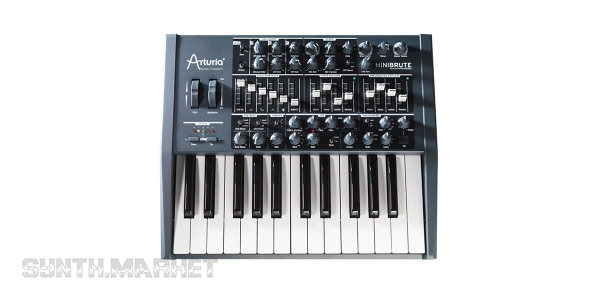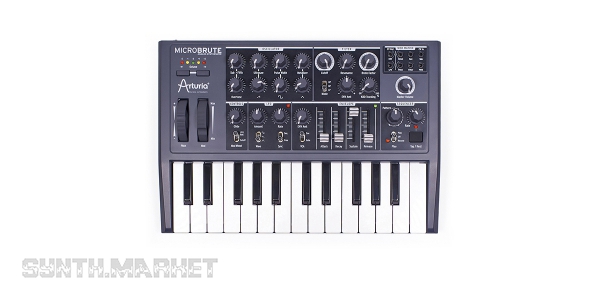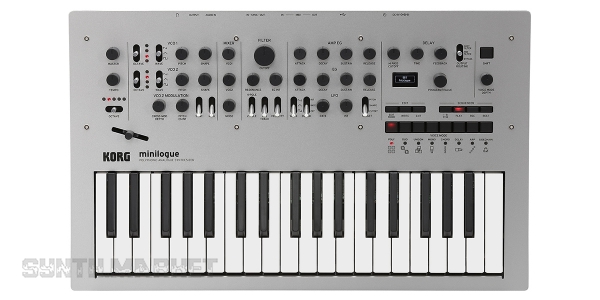 Does KORG Minilogue has any drawbacks? When a synthesizer costs $499 we should think not about the depth of functionality or range of exclusive possibilities, but about the quality of those specs we get for this price. Though we might want to stop for a minute and observe its admirable aluminum front panel and a rad looking insert made of wood this mini synthesizer wasn’t created for the sake of beauty – it’s a decent analog machine. It is based on 8 analog oscillators (2 VCOs per voice) producing sawtooth, triangle and square waveforms + one sub oscillator available in mono mode. The sound is Minilogue’s forte for sure and Korg succeeded in making the emphasis on the lively VCOs while other synthesizers incorporate orderly DCOs. The 3-octave instrument features an unhindered generation of various sounds with serious and impressive textures: roaring bass, evolving pads, a multilayer unison, craftily imitated Wurlitzer and MS-20. There are also a MIDI syncable LFO, white noise generator and a 16-step polyphonic sequencer with real time overdub function and MIDI output. A 4-voice polyphony and 8 voice modes (Poly, Duo, Unison, Mono, Chord, Delay, Arp and Sidechain) supporting Voice Mode Depth function will deploy the chords in a variety of sequences. Cross, ring, pulse-width modulation as well as pitch and shape modulation, assignable envelope generators represent the signal processing options. It’s quite easy to control the settings: practically each knob on the front panel is dedicated to one of the functions. Besides, for the first time the synthesizer (of this segment) offers a waveform visualization possibility which comes in handy.
Does KORG Minilogue has any drawbacks? When a synthesizer costs $499 we should think not about the depth of functionality or range of exclusive possibilities, but about the quality of those specs we get for this price. Though we might want to stop for a minute and observe its admirable aluminum front panel and a rad looking insert made of wood this mini synthesizer wasn’t created for the sake of beauty – it’s a decent analog machine. It is based on 8 analog oscillators (2 VCOs per voice) producing sawtooth, triangle and square waveforms + one sub oscillator available in mono mode. The sound is Minilogue’s forte for sure and Korg succeeded in making the emphasis on the lively VCOs while other synthesizers incorporate orderly DCOs. The 3-octave instrument features an unhindered generation of various sounds with serious and impressive textures: roaring bass, evolving pads, a multilayer unison, craftily imitated Wurlitzer and MS-20. There are also a MIDI syncable LFO, white noise generator and a 16-step polyphonic sequencer with real time overdub function and MIDI output. A 4-voice polyphony and 8 voice modes (Poly, Duo, Unison, Mono, Chord, Delay, Arp and Sidechain) supporting Voice Mode Depth function will deploy the chords in a variety of sequences. Cross, ring, pulse-width modulation as well as pitch and shape modulation, assignable envelope generators represent the signal processing options. It’s quite easy to control the settings: practically each knob on the front panel is dedicated to one of the functions. Besides, for the first time the synthesizer (of this segment) offers a waveform visualization possibility which comes in handy.
Minilogue embraced a high quality sound, 2/4-pole multimode filter, punchy ADSR envelopes, 200 preset locations, 16-step polyphonic sequencer, 14-mode arpeggiator, audio in which put signals through filters, envelopes and delay effect. And Korg doesn’t scare us away asking for it too much - $499 is quite a competitive price.
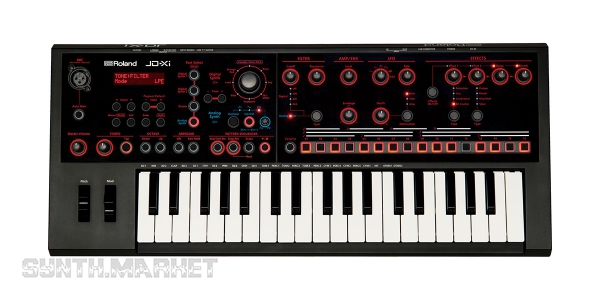 The same price tag embellishes another great variant – Roland JD-Xi the creators of which chosen an alternative path and developed a hybrid synthesizer with a crossover concept. A 3-octave features a 4-part multitimbrality. Its analog section comprises monophonic DCO producing 3 waveforms, sub oscillator (1-2 octaves lower), 4-pole low pass filter and analog amplifier. As for the digital section – it is represented by two parts based on PCM samples and drum synth. Each of the two sections supports a 64-voice polyphony and is built on Roland SuperNatural engine with comprehensible editing (almost as deep as in FA, Integra-7 or Jupiter which seem to be more powerful generating piano sounds and feature a wider sample set).
The same price tag embellishes another great variant – Roland JD-Xi the creators of which chosen an alternative path and developed a hybrid synthesizer with a crossover concept. A 3-octave features a 4-part multitimbrality. Its analog section comprises monophonic DCO producing 3 waveforms, sub oscillator (1-2 octaves lower), 4-pole low pass filter and analog amplifier. As for the digital section – it is represented by two parts based on PCM samples and drum synth. Each of the two sections supports a 64-voice polyphony and is built on Roland SuperNatural engine with comprehensible editing (almost as deep as in FA, Integra-7 or Jupiter which seem to be more powerful generating piano sounds and feature a wider sample set).
JD-Xi is aimed at dance music makers and offers 256 digital, 64 analog presets and 32 drum kits (453 drum waves). You can tweak the settings of the filter and amplifier envelopes, digital filters, modulation and LFO. You can’t put the digital components through the analog filters or layer them onto the analog section as in Roland JD-Xa but the problem can be solved with the help of a sequencer. JD-Xi offers a striking variety of effects including distortion, fuzz, compressor, bit crusher, flanger, phaser, ring modulator, slicer, delay and 6 reverb types. And again – this synth features a plummy quality/functionality proportion. That’s why its price hasn’t dropped yet though it’s been a year since it was put into production. Moreover, Roland keeps on announcing firmware updates with new sounds and limited edition white and red models in order to draw more attention. Buy all three of them – it would still seem quite a bargain!
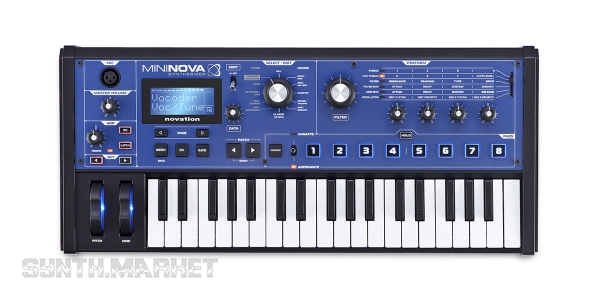 Talking about mini synthesizers we should definitely mention Novation MiniNova which is based on Ultranova concept. In 2015 the compact version was updated and released as a special edition called MoroderNova technically replicating MiniNova but having onboard a sample library of sounds featuring the music of the legendary Italian composer Giorgio Moroder who participated in and witnessed such genres disco, synthpop and electronic music at the dawn of their creation.
Talking about mini synthesizers we should definitely mention Novation MiniNova which is based on Ultranova concept. In 2015 the compact version was updated and released as a special edition called MoroderNova technically replicating MiniNova but having onboard a sample library of sounds featuring the music of the legendary Italian composer Giorgio Moroder who participated in and witnessed such genres disco, synthpop and electronic music at the dawn of their creation.
Despite the portable size of the instrument, its functionality is truly comprehensive (thanks to the inherited synth engine). It’s monotimbral as well as fully compatible with the patches featured in UltraNova. The signal flow is generated by 3 oscillators, multimode filters and 5 simultaneous effects. The whole generation process is represented by 4 standard waveforms, 9 saw/pulse combinations, 20 digital + 36 wavetables allowing syncing for each oscillator and enabling density detune function in order to shape super-saw effects. There are 4 noise types and 2 ring modulators. As much as Ultranova is, the digital sound of MoroderNova is often compared to Access Virus.
The filters include drive section with 7 variations. 3 LFOs and 6 assignable ADSR envelopes (with individually adjusted attack, decay and sustain stages) are among modulation possibilities.
Of course, the main distinction of the new mini synth is the patch selection by Giorgio Moroder (samples cut out of his compositions) which filled the unique third bank of presets up to 50 sounds leaving 78 slots for user combinations. According to some reviews Novation could have provided us with more quality because the patches leave much to be desired but it’s not an issue – you can solve the problem by adjusting the sounds the way you like them to be.MoroderNova sports a 12-band vocoder with a vocal tune effect.
If you know exactly how to use this instrument and your workplace is already laden with DJ equipment the keyboard of this mini synth might not seem an obstacle when you’ll be choosing between UltraNova and MiniNova/ MoroderNova and opting for that special edition unit.
Arturia MiniBrute became one of those modern analog irrefutable classics – a great example of a compact device released by Arturia (the company which used to be a soft developer) in 2012. The mono synthesizer with one VCO featuring no menu or presets surprised the market and became popular thanks to its recognizable aggressive sound and Brute Factor brand controller which is quite an affordable treat.
Steiner-Parker multimode filter together with Ultrasaw control for a saw wave and Metalizer control for a triangle waveform reveal all the hidden capabilities of the mono instrument. Mixer allows you to combine waveforms adjusting the volume of each. Multimode arpeggiator offers basic parameters; the keyboard has 25 semi-weighted velocity sensitive keys with aftertouch. The concept of MiniBrute is to play “right here and right now”.
Unlike MiniBrute which LFO was responsible for phasing/chorusing modulation, MicroBrute relies upon its modular patch bay. Its pulse-width modulation effects can result in cunning harmonics due to the fact that the saw waveform is a little bit out of phase with the square wave. Micro also sports a peculiar sub oscillator with the overtone parameter. Comparing to Mini which has 2 ADSR envelopes and 2 LFOs there’s only one envelope generator and one low frequency oscillator. But the patch bay allows directing the voltage onto any of the adjustable parameters. Sequencer offers 8 memory slots (64 steps per each).
The distinctive analog voice of MiniBrute and MicroBrute, basic functionality and a low price for such a popular synthesizer prove mini keyboards to be sufficient and relevant and ensure the growth of the demand on the market.

